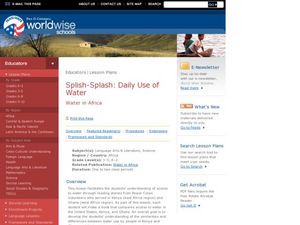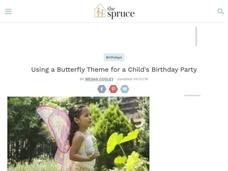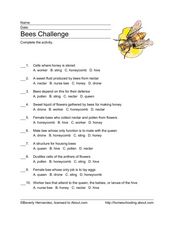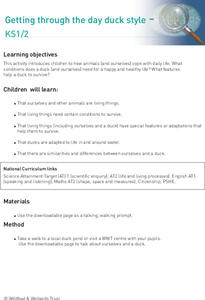Curated OER
Cloudy vs. Clear
Students analyze line plots. For this weather lesson using real NASA data, students discuss how weather affects the way the Earth is heated by comparing different line plots.
Curated OER
A Pressing Project
Students create a collection of pressed plants. In this plant lesson, students use newspaper, plywood, and a rubberband to press plants they previously collected.
Curated OER
Native Beauty
Students plant wild flowers and maintain their garden. In this wild flowers lesson plan, students pick and prepare a gardening site, plant wild flowers, and maintain it everyday.
Curated OER
Growing Garden Companions.
Students understand that some plants grow better with other plants. In this companion planting instructional activity, students observe the "three sisters" growing system used by the Native Americans. Students understand that small...
Curated OER
Preserving Buds and Blooms
Students learn how to preserve flower buds and blooms. In this gardening activity, students explore the methods of air drying, using drying agents, and pressing plants to preserve them.
Curated OER
Coaxing Flower Bulbs
Young scholars complete an experiment for coaxing flower bulbs into growth. In this flower growth lesson, students research various types of flower bulbs that may be used to complete a coaxing experiment. Young scholars then complete a...
Curated OER
Soaring in the Solar System
Who doesn't love learning about space? This presentation provides a mnemonic device and a song to help young students remember the names and basic facts about each of the nine planets in our solar system.
Curated OER
Old Made New
Students explore recycling. In this science lesson, students sort everyday objects based on their properties. Students view examples of items made from recycled paper. Students create recycled paper.
Curated OER
Splish-Splash: Daily Use of Water
Young scholars explore the daily use of water in Kenya and Ghana. In this Peace Corps lesson, students compare similarities and differences between water use by people in Kenya and Ghana and their own communities as they create books...
Curated OER
Splish Splash
Young scholars study drinking water. In this environment lesson plan, students draw the path of drinking water from the place of precipitation to the tap after researching a map and information from the United States Geological Survey...
Curated OER
The Koala Life Cycle
Students ask and answer questions about the koala life cycle while visiting the zoo. In this koala lesson plan, students review mammal characteristics, read books about koalas, and answer questions about koalas while at the zoo.
Curated OER
Mixed Media Ocean Art
Students design pictures of ocean environments. For this art lesson, students use mixed media art materials to develop a picture that depicts the ocean environment. They use paint, sand paper and various basic art materials.
Curated OER
Caterpillar to Butterfly
Students draw the life cycle of a butterfly. In this life cycle lesson plan, students read about and discuss the life cycle and then draw what they have learned.
Curated OER
Clouds: A weather Predictor
Predicting the weather can be as easy as understanding cloud formations. This presentation elucidates to the reasons clouds exist and how they are classified into four different types, cumulus, stratus, vertical, and cirrus. Tip: Take...
Curated OER
Ears Here!
Students participate in an interactive video to review the five senses. They perform hands-on activities to test their sense of hearing and play a hearing game from the Internet.
Curated OER
Water Wonders
Learners measure the amount of surface tension using a balance scale after a classroom demonstration students diagram the appearance of several liquids and label them.
Curated OER
Clam Crossword
In this clams crossword puzzle activity, students use the 10 clues and the terms in the word bank to help them correctly complete the word puzzle.
Curated OER
Bees Challenge
For this bees worksheet, students respond to 10 multiple choice questions regarding bees and their behavior in order to exhibit what they know about them.
Curated OER
Bees Vocabulary
In this bees vocabulary worksheet, students read ten clues to words pertaining to bees. Students choose the correct word that fits each clue and print it on the line. There is a word bank provided.
Curated OER
Dinosaur Vocabulary 2
In this dinosaur vocabulary skills worksheet, students match the 11 listed dinosaur-related terms to the appropriate sentences that describe each of them.
Curated OER
Making Choices, Setting Goals
Students compare wetland functions and values, and select those to be incorporated in the planned wetland. They formulate goals for the project as they model decision-making skills.
Curated OER
Getting Through the Day Duck Style
Students observe ducks at a local wetland. They answer various questions about the ducks behavior and write the answers on a downloadable worksheet.
Curated OER
Stella the Swan
Students study the similarities and differences between ducks, geese, and swans. They tell the story about how water fowl adapt to life in water using props.
Curated OER
Who Lives with Mallard?
Students color a picture of the habitat featuring mallard and other creatures, some of whom might be camouflaged or half-hidden. They discuss other forms of animal adaptation.

























